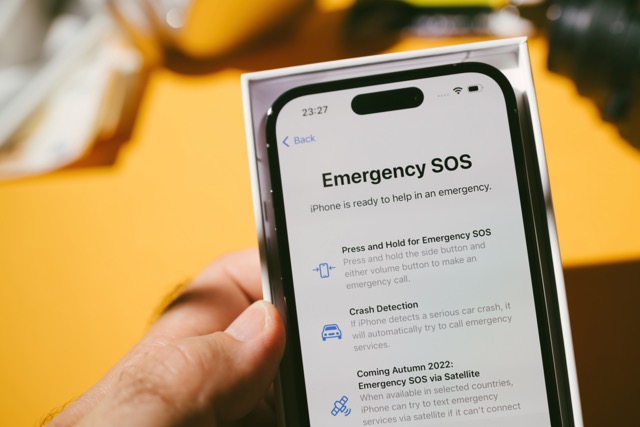Table of Contents
When you see “SOS” or “SOS Only” on your iPhone, it means your phone can only connect to emergency services. This typically occurs when your iPhone cannot reach your carrier’s network, but still has access to another network for emergency calls.
Why Is This Important?
The feature ensures that you can always make an emergency call, even when your regular network is unavailable. This can happen in situations such as:
- You are in a remote area with limited network coverage.
- There’s a temporary service outage from your provider.
- Your SIM card is inactive or not recognized.
Understanding the Key Features:
Here’s how the SOS mode on your iPhone works:
- Emergency Access: Even without cellular service, your iPhone can connect to any available network for emergency services.
- Automatic Activation: You don’t need to manually activate the SOS mode. It appears automatically when your device detects network issues.
- Visual Indicator: The “SOS” icon replaces your normal signal bars at the top right corner of your screen when this mode is enabled.
Why Does SOS Appear on Your iPhone?
If you’re wondering, “what does SOS mean on iPhone,” it’s essential to understand why it appears. “SOS” or “SOS Only” shows up on your iPhone when your device loses connection to your usual carrier but can still reach emergency services. This mode allows you to make emergency calls even without normal network service.
Common Reasons for SOS Mode:
- Poor Network Coverage:
Your iPhone displays “SOS” when it’s unable to connect to your carrier’s network. This can happen in:- Remote areas with limited or no cellular coverage.
- Underground locations, such as subways or tunnels.
- Buildings with thick walls that block signals.
- Carrier Outage:
If your carrier is experiencing an outage, your phone may lose access to its services. In such cases, the SOS icon appears, but emergency calls are still available through another network. - SIM Card Issues:
If your SIM card is damaged, not properly inserted, or deactivated, your phone won’t connect to your carrier. This is another scenario where “SOS Only” mode might activate. - Roaming or International Travel:
When traveling abroad, especially in countries where your carrier doesn’t provide service, your iPhone might enter SOS mode, allowing emergency calls on local networks.
What Does SOS Mean on iPhone and How Can You Fix It?
Here are some steps you can take to restore normal service:
- Move to a better coverage area: Find an open or higher location.
- Restart your iPhone: This may resolve temporary connectivity issues.
- Check for network settings updates: Go to Settings > General > About, and see if any updates are available.
How Does SOS Work?
When asking “what does SOS mean on iPhone,” it’s crucial to understand how the feature functions. SOS mode on iPhone allows you to make emergency calls even when your phone has lost connection to your regular cellular network. The feature is designed to ensure that you can reach emergency services whenever you need them.
How iPhone SOS Works:
- Emergency Call Functionality:
Even when your phone shows “SOS Only,” it will still connect to any available cellular network for emergency calls. Your iPhone bypasses regular carrier restrictions, ensuring you can reach services like:- 911 in the U.S.
- 112 in the European Union
- Other local emergency numbers depending on your location.
- Automatic Network Switching:
Your iPhone automatically switches to SOS mode when it detects a lack of connection with your usual network but identifies that another network is available for emergency use. This switching happens seamlessly and ensures you can still make critical calls. - Location Sharing with Emergency Services:
If you call emergency services through SOS mode, your iPhone may share your location automatically. This helps first responders find you more quickly in an emergency. - Emergency SOS via Satellite (on supported models):
On some newer iPhone models, you can also access Emergency SOS via satellite if you’re in a remote area without cellular or Wi-Fi coverage. This feature allows you to send a message to emergency services through a satellite connection.
Benefits of iPhone SOS Mode:
- Available in remote areas: Even without a network signal, you can still make an emergency call.
- Cross-network capability: SOS connects you to other networks when your own provider is unavailable.
- Safety assurance: SOS ensures you can always reach help in dangerous situations.
What to Do When SOS Appears on iPhone
When you see “SOS” or “SOS Only” on your iPhone, it’s a sign that your device is unable to connect to your regular network, but it can still make emergency calls. Understanding “what does SOS mean on iPhone” helps you react quickly to regain full functionality. Here’s a guide on what to do when this happens.
Steps to Take When SOS Appears:
- Check Your Location:
Poor network coverage is often the cause of the “SOS” mode. To resolve this:- Move to an area with better signal strength.
- Avoid areas known for blocking signals, like underground spaces or buildings with thick walls.
- Enable and Disable Airplane Mode:
Turning Airplane Mode on and off can refresh your phone’s connection to the network.- Swipe down from the top-right corner (on newer iPhones) or up (on older models) to access Control Center.
- Tap the airplane icon to turn on Airplane Mode, wait a few seconds, and then tap it again to reconnect.
- Restart Your iPhone:
A simple restart can often fix connectivity issues.- Press and hold the power button and a volume button until you see the “slide to power off” option.
- After the phone shuts down, hold the power button to restart.
- Update Carrier Settings:
If the issue persists, it could be due to outdated network settings. To update:- Go to Settings > General > About.
- If a carrier settings update is available, you’ll see an option to update them.
- Check Your SIM Card:
Ensure your SIM card is properly inserted and functioning. If your SIM card is damaged or misaligned, it may cause your phone to enter SOS mode. You can check your SIM card by:- Turning off your phone, removing the SIM card tray, and then re-inserting the SIM.
Additional Troubleshooting:
- Contact Your Carrier:
If none of these steps work, the problem may be with your carrier. Reach out to them for assistance. - Visit an Apple Store:
If you’re still facing issues, visiting an Apple Store or authorized repair center may help identify hardware problems.
How to Prevent SOS Mode From Activating
If you frequently see “SOS” or “SOS Only” on your iPhone, it’s important to know how to prevent it. Understanding “what does SOS mean on iPhone” helps you take steps to avoid the issue. Below are some strategies to keep your iPhone connected to your carrier’s network and prevent SOS mode from activating.
Tips to Prevent SOS Mode:
- Stay in Areas with Strong Signal:
SOS mode often occurs in areas with poor network coverage. To prevent this:- Try to stay in locations where your carrier provides reliable signal strength.
- Consider using Wi-Fi Calling in areas with weak cellular signals.
- Keep Your Carrier Settings Updated:
Outdated carrier settings can sometimes cause connectivity issues. To ensure smooth communication with your network:- Go to Settings > General > About to check for a carrier settings update.
- If an update is available, a notification will appear allowing you to install it.
- Avoid SIM Card Issues:
A damaged or improperly inserted SIM card can trigger SOS mode. To prevent this:- Ensure your SIM card is securely in place.
- If you’re frequently switching SIM cards, handle them carefully to avoid damage.
- Turn Off Automatic Network Switching:
Some iPhones have an option to switch between networks, which may trigger SOS mode if the phone fails to connect to a new network. To prevent this:- Go to Settings > Cellular > Cellular Data Options, and check if automatic switching is on. Turning it off might help stabilize the connection.
- Reset Network Settings:
Resetting your network settings can fix recurring issues with signal loss. This process won’t delete your data but will reset Wi-Fi networks, passwords, and carrier settings.- Go to Settings > General > Reset > Reset Network Settings.
Other Preventive Measures:
- Check for iOS Updates:
Apple regularly releases iOS updates that improve performance and connectivity. Make sure your iPhone is running the latest version by checking Settings > General > Software Update. - Use a Signal Booster:
In areas where network coverage is weak, using a signal booster can help improve your connection and prevent your phone from entering SOS mode.
is a skilled Web Developer and Designer. He builds and designs websites that focus on best UI/UX practices. Justin is also a Verizon Product Expert at Victra, helping customers with Verizon products and services. His mix of design, coding, product, and general knowledge makes him a valuable and knowledgeable team member.




